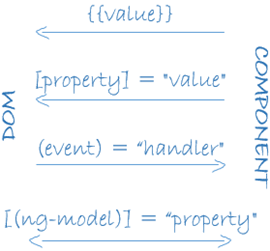Architecture - High Level
Angular architecture
- Angular is a platform and framework for building single-page client applications using HTML and TypeScript.
- The basic building blocks of the Angular framework are Angular components that are organized into NgModules.
- Organizing your code into distinct functional modules helps in managing development of complex applications, and in designing for reusability. In addition, this technique lets you take advantage of lazy-loading
Angular - an overview
Building blocks of Angular and their relation
>
Module
Every application has at least one module
import {NgModule} from "@angular/core";
import {AppComponent} from "./app.component";
import {HttpModule} from "@angular/http";
import {CustomerService} from "./customer.service";
@NgModule({
declarations: [AppComponent],
imports: [HttpModule],
providers: [CustomerService],
bootstrap: [AppComponent]
})
export class AppModule {}
@NgModule Decorator
A function that expects an object as argument
- declarations - ALL components, pipes and directives of this module
- exports - a subset of the declarations, that can be used by other modules that import this module
- imports - other modules we use
- providers - globally available services and injectables that should be available for the dependency injector
Services
- are provided with the dependency injection
- are simple TypeScript classes
- are injected by their Type
- need the decorator @Injectable()
- are normally singletons (when they are provided on the root module level, or in a module that is only imported by the AppModule)
A simple service example
import { Injectable } from '@angular/core';
@Injectable({
providedIn: 'root', // if provided in the root module. Used for tree-shaking
})
export class MyAwesomeService {
constructor() { }
sayHello() {
console.log('Hello');
}
}
Components
- are the basis of our application
- are the central concept in Angular
- the logic is inside of the TypeScript class
- Services can be injected
Templates
- HTML - describes how the component should look like
- can be defined either inline or in an html file
- can contain multiple other components
- contains Angular specific template syntax
Data Binding

Binding in Templates
{{person.name}}
- Interpolation: {{person.name}} - shows the value of the person.name property
- Property Binding: [person] - hands over the value of "selectedPerson" to the person component
- Event Binding: (click) - for each click, calls selectPerson()
Directives
- 3 types of directives
- Components - directives with a view
- structural directives - change the structure of the DOM, e.g. *ngIf
- attribute directives - change the behaviour or the look and feel of a dom element, e.g. ngStyle
Additional features
- Change Detection (when the view needs to re-render)
- Observables
- Animations
- Forms & Pipes
- HTTP Communication
- Router
- Testing
Any questions?
